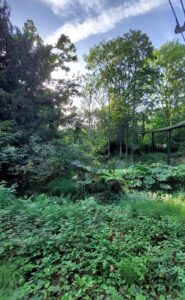Trees face many challenges, not least of which is the threat to their health posed by diseases such as ash dieback and insect ‘pests’ such Ips typographus (the eight-toothed European spruce bark beetle) recently found in the UK.
Vigilance against these threats is a priority for governments and forest owners alike. The most common method used by woodland managers to determine the initial presence and spread of pests and diseases within their forests is direct visual inspection. By physically moving through a woodland, a manager can study individual trees in turn, search for signs and symptoms which might individuate those with a pest or disease. The limitations of this should be obvious; it is often slow, and can be physically challenging, especially in areas with a dense understory (smaller plants which fill the forest floor) or over challenging terrain.
Woodlands can be vast, with the largest in the UK covering almost 300 square miles. Visiting and directly survey even a fraction of the total arboreal coverage of the country is functionally impossible. Perhaps even more limiting however, is that even when woodland managers do move through a woodland, without the use of expensive and dangerous tree climbing such surveillance is intrinsically grounded: that is, with little to no access to the upper parts of the trees (the ‘canopy’). Whilst manual aerial inspections can be carried out by helicopter or fixed-wing aircraft, they are often expensive and still rely on eventual ground inspection.
Enter, the ASPEN project: with hopes to use autonomous drones, alongside other trusted autonomous systems, to rise to this arboreal challenge. The capabilities offered by autonomous systems create many potential contributions to the protection of trees and forests. Drones can not only fly high enough to bring direct observation to the upper parts of even large trees over a wide area, but can also be small enough to move below and within the canopy. Ground-based robots are also being tested in forest settings, and the woodland manager of the future will almost certainly augment their surveillance and other forest protection activities by deploying these autonomous systems. ASPEN aims to be part of that evolution of practice and is testing elements of an autonomous platform, alongside exploration of the governance and ethics of their potential deployment.
In a world where autonomous systems can be seen as a threat to jobs, it is important to recognise that ASPEN is focused on overall capacity building, not replacing woodland managers: providing managers with increasingly effective tools which can significantly augment their ability to do the work they do. By utilising autonomous drones, a woodland manager could vastly increase their reach, both horizontally – covering more ground, especially in rough terrain – and vertically – as the tree canopy is brought under direct observation in a cost-effective and accessible way. These managers are not, however, the only stakeholder in the forest and, as in other arenas, it will be critical to ensure that any deployed autonomous system is widely trusted.
Here is a promotional film of this project.

This blog was by Dr Seumas Bates and Dr Norman Dandy at Bangor University, you can read more about the project here